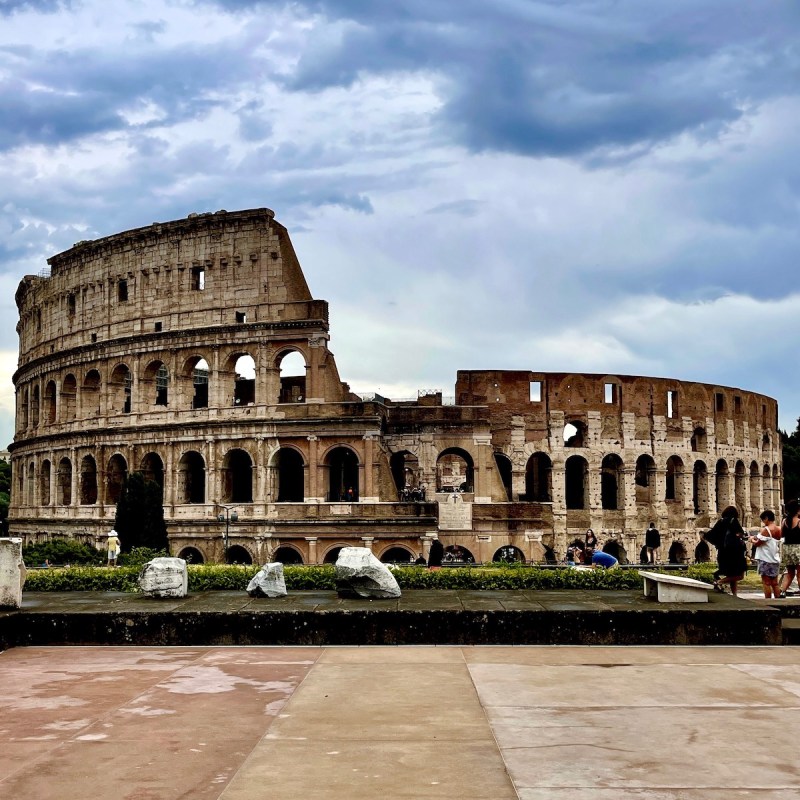
The Colosseum is considered a symbol of Ancient Rome for its incredible architecture and gruesome past. It’s one of the most iconic structures in the eternal city, or as the Romans call it “La Citta Eterna.” They believed no matter how many empires rose or fell, Rome would live on forever. They were right. The Colosseum still stands against the gorgeous skyline today. To fully appreciate its massive scale, one must take a tour to fully appreciate how and why it was built. It was a massive undertaking opening a decade after construction began in A.D. 72.
Videos by TravelAwaits
There is so much to discover about the building that a guided, small-group tour is required to fully appreciate the history of the Roman Colosseum. We chose the Complete Colossseum Underground Tour with What A Life Tours after reviewing other companies because we wanted to explore both the Colosseum, the underground, and the Roman Forum. Here are 5 reasons to book a small-group tour when visiting this timeless city.

1. Optimal Time In The Colosseum
We researched tour companies and purchased tickets from What A Life Tours. It’s important to choose a company with positive reviews (this tour consistently receives five stars) and one that offers exclusive access to areas other tours don’t, including a “skip the entrance line” perk. With over 6 million visitors annually, the Colosseum is one of the most popular places to visit in Rome, and the lines are lengthy. Our tickets brought us through a specific gate — leaving the crowds behind and allowing us more time to fully enjoy the experience of touring through this ancient wonder of the world and the adjacent Roman Forum.

2. Access To The Colosseum’s Underground
Our tour offered exclusive access to the Underground of the Colosseum, normally a restricted area of the building. The price was worth every penny for this option. The size of our group — capped at 12 participants — made it easier to travel through the narrow corridors and see each section up close.
We stopped often and were able to gather around our knowledgeable guide to hear him explain the history of the underbelly. Headphones are also provided to make sure participants don’t miss anything the guide shared.
The History Of The Underground
Our guide told us tales of huge beasts such as lions, tigers, elephants, and panthers imported from Africa and the Middle East. Once transported to the arena gladiators would fight them to the death for the roaring crowds or hunt them for show.
As we moved through the area, we observed graffiti scratched into the marble by the anxious fighters. It was an incredible step back into history. Archeologists discovered and reconstructed elevator shafts that loaded the gladiators, exotic animals, or elaborate sets via a pulley system hauled by slaves up several stories to the arena floor. The construction of these elevators was mind-boggling as they were a marvel at the time. From here you can look upward to see where the arena floor once covered the maze of tunnels and corridors.
While gladiators were the main attraction, it was also the place to see dramas, comedies, reenactments of epic battles, and public executions.

3. The Gladiator’s Gate
Once you’ve experienced the ground floor, you climb the steps and walk out onto the now partial arena floor through the Gladiator’s Gate. Here you can imagine what it was like to be surrounded by all those spectators cheering and clapping at the spectacle unfolding on the stage. As you look around the incredible monument, you will hear stories of epic battles and gladiators who survived to fight another day. Then you will continue the tour into the stands to see down onto the main stage. The emperors and their guests had the best seats closest to the action.
The Emperor’s marble seats were in a box behind a mesh screen to protect him (and his guests) from the events in the arena. Seated behind his group were the senators, then the businessmen. Above them were the commoners, and at the top were foreigners, enslaved people, and women. Above these seats was a great awning that offered shade to the nosebleed seats. At the very top of the arena, you’ll see artifacts in the museum area — now protected by glass — that give more information about the fighters and events that played out daily.

4. The Roman Forum
Our ticket included a walking tour of the Roman Forum, adjacent to the Colosseum. The Roman Forum ruins are remarkable, and it’s still an active site for archeologists who continue to discover more about what took place on the grounds. Prior to the Colosseum’s grand opening, gladiators fought there. Before that, it was a market for daily shopping. Eventually, the Forum became a courtroom and a location for political debate.
After the Etruscan kings were overthrown, Rome became a republic around 500 B.C. The republic became one of the early examples of a democracy with representatives selected from some of the wealthiest citizens who decided on the fate of everyone else. The Roman people protested, and assemblies were formed for better representation of more of the society. The Senate and various assemblies would pass laws and declare war on their neighbors to grow the empire. By the first century B.C., Rome was the dominant power in the Mediterranean.
5. The Temple Of Vesta
The Temple Of Vesta was one of ancient Rome’s most important buildings. It was the place where Senate documents and the statue of Minerva (Athena) were placed. The temple was dedicated to the Roman Goddess of the hearth and held the city’s sacred flame, the symbol of Rome. Vestal Virgins were “brides” of Vesta and held the important job of keeping the fire burning — holding special secrets known only to them.
There was a long list of requirements to join the Vestals. They were chosen at the age of 6 (up to 10 years old) and had to remain pure until the age of 30, when they were free to marry and leave the sacred order. Many remained true to their vows for the rest of their lives. These women were highly regarded and taken care of during their time as observers of the flame. They were severely punished if they broke their vows, so many remained true in their service to Vesta.

A Brief History Of The Colosseum
When the Colosseum was completed, it measured 620 by 513 feet, rose four stories high, and offered access with 80 separate entrances. (Two were made specifically for the Emperor and the Vestal Virgins, and two were for the gladiators.) 50,000 spectators filled the arena at full capacity. Emperor Titus celebrated the opening with 100 days of gladiator games. Eventually, the Romans lost interest in attending these shows. After multiple earthquakes in the 5th century, two-thirds of the building was destroyed. A restoration project in the 1990s helped uncover new discoveries about the Colosseum and repair what was left of the site.
Pro Tips: Visiting The Colosseum
You will walk for at least 3 hours and climb stairs in the Colosseum. Dress appropriately for the weather and wear comfortable shoes. Make sure to check the forecast. We came unprepared for rain and needed to purchase ponchos for part of our tour. Make sure to have water and pack an umbrella if rain is a possibility. Don’t forget your camera; the experience offers many photo opportunities that you won’t want to forget once you get back home.
